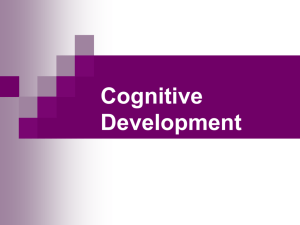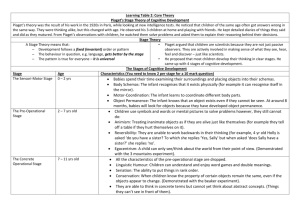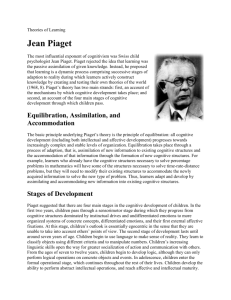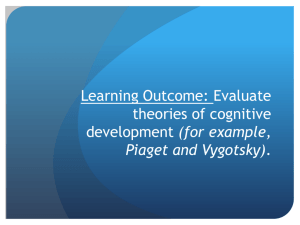cognitive development
advertisement
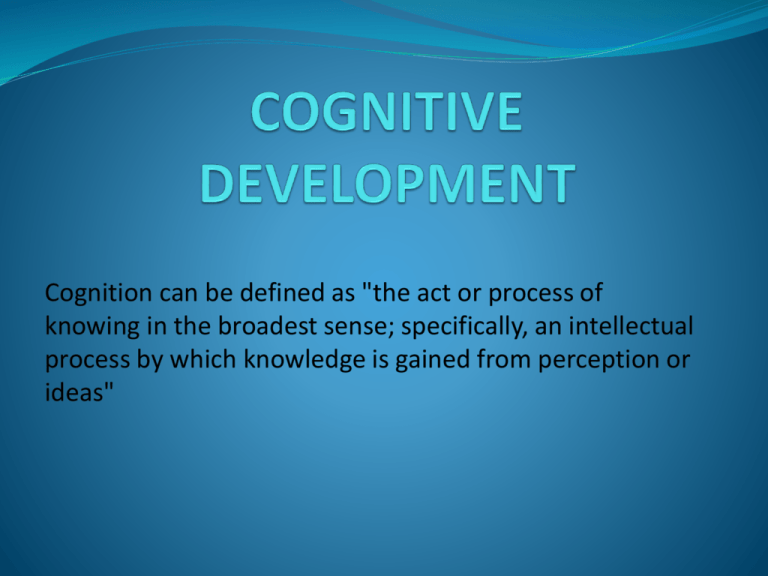
Cognition can be defined as "the act or process of knowing in the broadest sense; specifically, an intellectual process by which knowledge is gained from perception or ideas" Jerome Bruner and Cognitive Development Bruner's work in cognitive psychology led to an interest in the cognitive development of children and related issues of education, and in the 1960s he developed a theory of cognitive growth. Bruner's theories, which approach development from a different angle than those of Jean Piaget, focus on the environmental and experiential factors influencing each individual's specific development pattern. His argument that human intellectual ability develops in stages from infancy to adulthood through step-by-step progress in how the mind is used has influenced experimental psychologists and educators throughout the world. Bruner is particularly interested in language and other representations of human thought. Enactive Action: It implies that most of the activities of the child are motor activities and are related to motor nerves. Iconic Image: At this stage the child is guided by his mental imagery. He is able to form his own mental images and expresses himself on that basis. Symbolic Word: The child at this stage expresses himself in the form of words. He comes to have a mental sense of time and distance. At this stage language learning also begin. Jean Piaget and Cognitive Development Jean Piaget began his career as a biologist. But his interest in science and the history of science soon overtook his interest in snails and clams. As he delved deeper into the thought-processes of doing science, he became interested in the nature of thought itself, especially in the development of thinking. Finding relatively little work done in the area, he had the opportunity to give it a label. He called it genetic epistemology, meaning the study of the development of knowledge. Piaget’s stage theory describes the cognitive development of children. Cognitive development involves changes in cognitive process and abilities. In Piaget’s view, early cognitive development involves processes based upon actions and later progresses into changes in mental operations. Key Concepts Schemas : Schemas are categories of knowledge that help us to interpret and understand the world. In Piaget’s view, a schema includes both a category of knowledge and the process of obtaining that knowledge. As experiences happen, this new information is used to modify, add to, or change previously existing schemas. Assimilation – The process of taking in new information into our previously existing schema’s is known as assimilation. The process is somewhat subjective, because we tend to modify experience or information somewhat to fit in with our preexisting beliefs. Accommodation – Another part of adaptation involves changing or altering our existing schemas in light of new information, a process known as accommodation. Accommodation involves altering existing schemas, or ideas, as a result of new information or new experiences. New schemas may also be developed during this process. Assimilation and accommodation are the two sides of adaptation, Piaget’s term for what most of us would call learning. Equilibration – Piaget believed that all children try to strike a balance between assimilation and accommodation, which is achieved through a mechanism Piaget called equilibration. As children progress through the stages of cognitive development, it is important to maintain a balance between applying previous knowledge (assimilation) and changing behavior to account for new knowledge (accommodation). Equilibration helps explain how children are able to move from one stage of thought into the next. Piaget's Stages of Cognitive Development Sensory Motor Period (0 - 24 months) Developmental Stage & Approximate Age Reflexive Stage (0-2 months) Primary Circular Reactions (2-4 months) Secondary Circular Reactions (4-8 months) Coordination of Secondary Reactions (8-12 months) Tertiary Circular Reactions (12-18 months) Invention of New Means Through Mental Combination (18-24 months) Characteristic Behavior Simple reflex activity such as grasping, sucking. Reflexive behaviors occur in stereotyped repetition such as opening and closing fingers repetitively. Repetition of change actions to reproduce interesting consequences such as kicking one's feet to more a mobile suspended over the crib. Responses become coordinated into more complex sequences. Actions take on an "intentional" character such as the infant reaches behind a screen to obtain a hidden object. Discovery of new ways to produce the same consequence or obtain the same goal such as the infant may pull a pillow toward him in an attempt to get a toy resting on it Evidence of an internal representational system. Symbolizing the problem-solving sequence before actually responding. Deferred imitation. The Preoperational Period (2-7 years) • During the preoperational stage, children also become increasingly adept at using symbols, as evidenced by the increase in playing and pretending. For example, a child is able to use an object to represent something else, such as pretending a broom is a horse. Role playing also becomes important during the preoperational stage. Children often play the roles of "mommy," "daddy," "doctor," and many others. •Egocentrism: Piaget used a number of creative and clever techniques to study the mental abilities of children. One of the famous techniques egocentrism involved using a three-dimensional display of a mountain scene. Children are asked to choose a picture that showed the scene they had observed. Most children are able to do this with little difficulty. Next, children are asked to select a picture showing what someone else would have observed when looking at the mountain from a different viewpoint. Invariably, children almost always choose the scene showing their own view of the mountain scene. According to Piaget, children experience this difficulty because they are unable to take on another person's perspective. Developmental Stage & Approximate Age Characteristic Behavior Preoperational Phase (2-4 years) Increased use of verbal representation but speech is egocentric. The beginnings of symbolic rather than simple motor play. Transductive reasoning. Can think about something without the object being present by use of language. Intuitive Phase (4-7 years) Speech becomes more social, less egocentric. The child has an intuitive grasp of logical concepts in some areas. However, there is still a tendency to focus attention on one aspect of an object while ignoring others. Concepts formed are crude and irreversible. Easy to believe in magical increase, decrease, disappearance. Reality not firm. Perceptions dominate judgment. In moral-ethical realm, the child is not able to show principles underlying best behavior. Rules of a game not develop, only uses simple do's and don'ts imposed by authority. Period of Concrete Operations (7-11 years) Logic: •Piaget determined that children in the concrete operational stage were fairly good at the use of inductive logic. Inductive logic involves going from a specific experience to a general principle. On the other hand, children at this age have difficulty using deductive logic, which involves using a general principle to determine the outcome of a specific event. Reversibility: •One of the most important developments in this stage is an understanding of reversibility, or awareness that actions can be reversed. An example of this is being able to reverse the order of relationships between mental categories. For example, a child might be able to recognize that his or her dog is a Labrador, that a Labrador is a dog, and that a dog is an animal. Period of Formal Operations (11-15 years) Thought becomes more abstract, incorporating the principles of formal logic. The ability to generate abstract propositions, multiple hypotheses and their possible outcomes is evident. Thinking becomes less tied to concrete reality. Logic: Piaget believed that deductive logic becomes important during the formal operational stage. Deductive logic requires the ability to use a general principle to determine a specific outcome. This type of thinking involves hypothetical situations and is often required in science and mathematics. Abstract Thought: While children tend to think very concretely and specifically in earlier stages, the ability to think about abstract concepts emerges during the formal operational stage. Instead of relying solely on previous experiences, children begin to consider possible outcomes and consequences of actions. This type of thinking is important in long-term planning. Problem-Solving: In earlier stages, children used trial-and-error to solve problems. During the formal operational stage, the ability to systematically solve a problem in a logical and methodical way emerges. Children at the formal operational stage of cognitive development are often able to quickly plan an organized approach to solving a problem.


